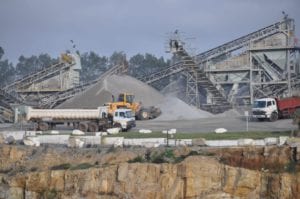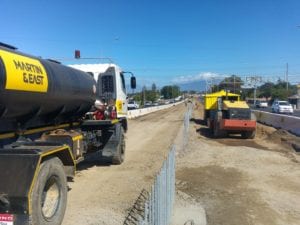In one of the largest contracts undertaken by Western Cape contractor Martin & East, the busy N1 highway between Durban Road and the R300 near Cape Town is getting a third lane in both directions, with a special blue stone supplied by leading construction materials supplier AfriSam.
 This R514 million project is being undertaken by the Western Cape Department of Transport and Public Works and began in early 2016. The project aims to significantly reduce congestion levels. It is estimated that 120 000 vehicles use the route daily, leading to regular and severe traffic delays during peak periods.
According to Eitner Truter, contracts manager at Martin & East, the project is making some important safety improvements to the interchanges. This includes the Jip de Jager Road, Plattekloof Road, Durban Road and Old Oak Road interchanges where widening of on- and off-ramps and improving of signalisation is being done.
“In-between these intersections, auxiliary lanes are being added to create a safer, more gradual merge of traffic into the faster N1 highway traffic,” says Truter. “Adding the additional lane into the median, on the north- and south-bound carriageways, means the concrete median barrier needs to be extended from the Jip de Jager Interchange onwards to the R300 Interchange.”
This R514 million project is being undertaken by the Western Cape Department of Transport and Public Works and began in early 2016. The project aims to significantly reduce congestion levels. It is estimated that 120 000 vehicles use the route daily, leading to regular and severe traffic delays during peak periods.
According to Eitner Truter, contracts manager at Martin & East, the project is making some important safety improvements to the interchanges. This includes the Jip de Jager Road, Plattekloof Road, Durban Road and Old Oak Road interchanges where widening of on- and off-ramps and improving of signalisation is being done.
“In-between these intersections, auxiliary lanes are being added to create a safer, more gradual merge of traffic into the faster N1 highway traffic,” says Truter. “Adding the additional lane into the median, on the north- and south-bound carriageways, means the concrete median barrier needs to be extended from the Jip de Jager Interchange onwards to the R300 Interchange.”
 UTFC
UTFC
The extra lane being constructed mainly uses an ultra-thin friction course (UTFC) design over the 8 km from the Plattekloof Interchange to the R300 Interchange, covering a total of 436 500 m2.
UTFC has been specified to improve the roadway safety qualities as it provides superior drainage, due to the shape and size of the smaller UTFC stone. Bradley Thomas, territory sales manager at AfriSam, highlights the cubical nature of the 9 mm and 13 mm stone, quarried and crushed at AfriSam’s Rheebok quarry. This particular stone has low levels of flakiness and creates the interconnected voids in the final 24 mm asphalt layer.
Water on the road surface drains via the top layer to the sides of the highway, channelling safely into drains and pipes. “Using an open-graded mix allows water to travel through the interconnected voids between the stones, and off the road surface,” Truter says.
Less water on the surface means vehicle tyres have improved grip so there is less risk of vehicles aquaplaning and of water spray impairing driver visibility. An added advantage is lower tyre noise, which is another reason why UTFC is gaining popularity in road design specifications in South Africa.
The UTFC asphalt mix is being supplied by Much Asphalt’s Contermanskloof Plant, established on the site of AfriSam’s Peninsula Quarry and within easy reach of the N1 construction. As the country’s largest supplier, the company has taken a leading role in keeping South Africa at the cutting edge of asphalt technology and it was the player that introduced UTFC to the local market.
Ensuring the highest-quality standards, Much Asphalt’s plants are wholly South African designs, working in compliance withISO 9001:2000 quality systems. The company operates its own certified laboratory in Cape Town for product testing.
 Readymix solutions
Readymix solutions
In addition to supplying the aggregate to Much Asphalt, AfriSam is also providing aggregates for the concrete mix design for the readymix being used on a number of applications on Martin & East’s contract.
Among the main applications are in situ median barrier units, 10 retaining structures on the outer edges of the highway, overhead gantry base structures, concrete-lined v-drains and the rebuilding of the 60-year-old bridge over the N1 on Old Oak Road.
“The addition of new lanes required this bridge to be demolished, as the vertical and horizontal clearances did not allow for the new legalised height limits for abnormal truck loads as well as the widening of the highway into the median area. A rebuild was necessary to reposition the piers,” says Truter. In addition, the bridge needed to be raised 900 mm to meet modernhighway regulations.
Work on the Old Oak Road bridge, which included concrete pours for the abutments, columns and spans, is over 60% complete, with two of the three spans completed by April 2018. The last span will be done by July 2018, after which pre-stressing starts, and bridge completion is expected in August or September this year. All approaches are planned to tie in with the increase in the bridge’s elevation.
 Dam pipeline relocation
Dam pipeline relocation
A further important element was relocating the water pipeline from Wemmershoek Dam to Cape Town. This used to run down the centre of the median. However, with the road and median barrier being extended, 2.5 km of the 12 m diameter pipeline had to be moved to the shoulder of the incoming N1 lane. This ensures that it will remain accessible from the surface, at a depth of about 3 m.
“This required four pipe-jacks under two of the four interchanges, as well as ensuring that the three million litres of water in that section of the pipe was not lost during the diversion process,” Truter says. This was achieved by transferring the water from the pipeline, using a pump station in Fairtrees Road, to the Glengarry reservoir, ensuring it could be used in theDurbanville area. Truter also highlights how the traffic intensity on this route makes for challenging logistics. Keeping the seven construction teams working in coordination while ensuring on-time deliveries from suppliers and maintaining high plant utilisation is no mean feat on this contract. “Disruptive work, such as lane closures, is not permitted during peak-hour traffic, for example,” he says. Thomas emphasises that this demands perfect timing from AfriSam, especially with its readymix concrete deliveries for the median barrier.
 “AfriSam systems ensure that our trucks arrive punctually and discharge the readymix within the strict time restrictions, despite the difficult traffic conditions,” Thomas explains. “Failure to do this could delay the entire construction process, perhaps by as much as a day, so there is no room for error.”
Thomas also emphasises the critical importance of AfriSam’s concrete quality management under these conditions.
“The limited window of opportunity to deliver the concrete makes it even more vital that quality is on spec at all times,” he says, “For this reason, a lab technician tests the slump at the AfriSam plant just before the truck leaves for site, and then accompanies the truck to site with the results.”
By April 2018, the number of personnel on-site was peaking at about 215 people, including management, labour and subcontractors, says Truter. Progress to date has been solid, with about half of the three-section contract completed. The first section of the highway has been completed, the second section is due for completion in August 2018, and the last section will be done by March 2019.
“AfriSam systems ensure that our trucks arrive punctually and discharge the readymix within the strict time restrictions, despite the difficult traffic conditions,” Thomas explains. “Failure to do this could delay the entire construction process, perhaps by as much as a day, so there is no room for error.”
Thomas also emphasises the critical importance of AfriSam’s concrete quality management under these conditions.
“The limited window of opportunity to deliver the concrete makes it even more vital that quality is on spec at all times,” he says, “For this reason, a lab technician tests the slump at the AfriSam plant just before the truck leaves for site, and then accompanies the truck to site with the results.”
By April 2018, the number of personnel on-site was peaking at about 215 people, including management, labour and subcontractors, says Truter. Progress to date has been solid, with about half of the three-section contract completed. The first section of the highway has been completed, the second section is due for completion in August 2018, and the last section will be done by March 2019.








